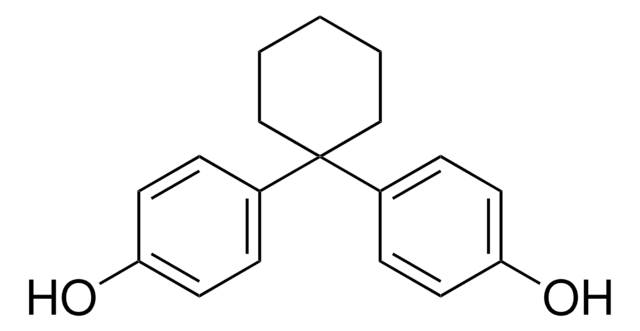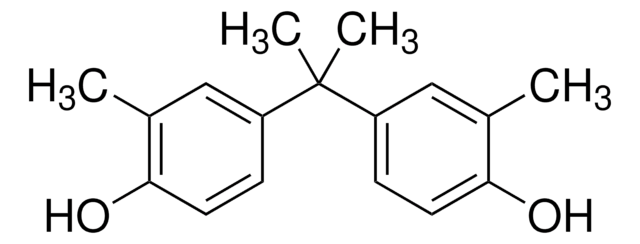B47006
Bis(4-hydroxyphenyl)methane
98%
Synonym(s):
4,4′-Methylenediphenol, Bisphenol F
Sign Into View Organizational & Contract Pricing
All Photos(1)
About This Item
Linear Formula:
CH2(C6H4OH)2
CAS Number:
Molecular Weight:
200.23
Beilstein:
2049425
EC Number:
MDL number:
UNSPSC Code:
12352100
PubChem Substance ID:
NACRES:
NA.22
Recommended Products
Assay
98%
form
crystals
mp
162-164 °C (lit.)
SMILES string
Oc1ccc(Cc2ccc(O)cc2)cc1
InChI
1S/C13H12O2/c14-12-5-1-10(2-6-12)9-11-3-7-13(15)8-4-11/h1-8,14-15H,9H2
InChI key
PXKLMJQFEQBVLD-UHFFFAOYSA-N
Looking for similar products? Visit Product Comparison Guide
Related Categories
Signal Word
Warning
Hazard Statements
Precautionary Statements
Hazard Classifications
Aquatic Chronic 2 - Eye Irrit. 2 - Repr. 2 - Skin Irrit. 2 - Skin Sens. 1
Storage Class Code
11 - Combustible Solids
WGK
WGK 2
Flash Point(F)
Not applicable
Flash Point(C)
Not applicable
Personal Protective Equipment
dust mask type N95 (US), Eyeshields, Gloves
Choose from one of the most recent versions:
Already Own This Product?
Find documentation for the products that you have recently purchased in the Document Library.
Customers Also Viewed
Pantelis Charisiadis et al.
Scientific reports, 8(1), 8186-8186 (2018-05-31)
Evidence of bisphenols' obesogenic effects on humans is mixed and inconsistent. We aimed to explore the presence of bisphenol A (BPA), bisphenol F (BPF) and chlorinated BPA (ClBPA), collectively called the bisphenols, in different brain regions and their association with
Masahiro Takeo et al.
Microorganisms, 8(2) (2020-02-26)
The nonylphenol-degrading bacterium Sphingomonas sp. strain NP5 has a very unique monooxygenase that can attack a wide range of 4-alkylphenols with a branched side chain. Due to the structural similarity, it can also attack bisphenolic compounds, which are very important
Zhiyuan Meng et al.
Chemosphere, 212, 297-306 (2018-08-27)
The widespread application of bisphenols (BPs) makes them ubiquitous in the natural environment and poses many potential risks. In this study, we examined the effects of perinatal exposure to BPA and its 3 alternatives (BPS, BPF, and BPAF) on lipid
Klara Hercog et al.
Toxins, 12(4) (2020-04-05)
Ever-expanding environmental pollution is causing a rise in cyanobacterial blooms and the accumulation of plastics in water bodies. Consequently, exposure to mixtures of cyanotoxins and plastic-related contaminants such as bisphenols (BPs) is of increasing concern. The present study describes genotoxic
Takahiro Masuya et al.
Scientific reports, 9(1), 9954-9954 (2019-07-11)
Bisphenol A (BPA) is used as an industrial raw material for polycarbonate plastics and epoxy resins; however, various concerns have been reported regarding its status as an endocrine-disrupting chemical. BPA interacts not only with oestrogen receptors (ERs) but constitutive androstane
Our team of scientists has experience in all areas of research including Life Science, Material Science, Chemical Synthesis, Chromatography, Analytical and many others.
Contact Technical Service













